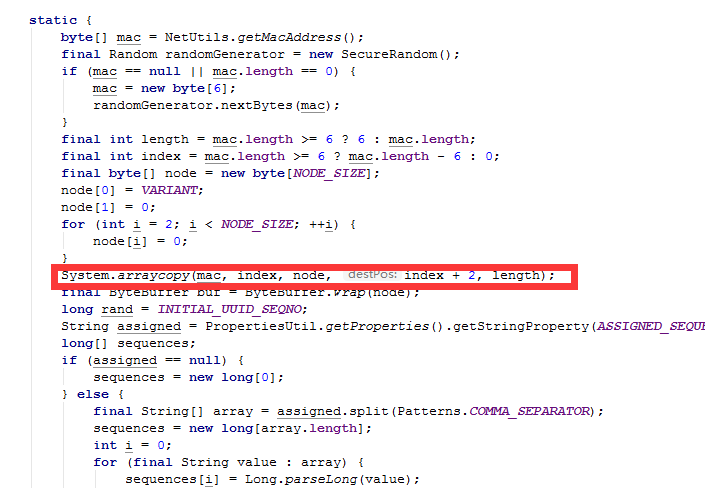log4j的一个bug
点击上方蓝色字体,选择“标星公众号”
优质文章,第一时间送达
作者 | dint
来源 | urlify.cn/nUr67v
java项目中使用log4j记录日志几乎成了标配,
最近一个项目中出了个问题 现象是这样的: 不连vpn程序一切正常,连上VPN启动程序 直接异常退出,
错误日志直接指向了 log4j 库
org.apache.logging.log4j.core.util.UuidUtil.clinit
就是说在 UuidUtil 这个类初始化时出了问题最终错误在此处

数组index超界
原因是在我的机器上不连vpn mac是一个长度为6的数组 连vpn后长度为8 了
mac长度为8 则 length=6 index=2
则等价于:
mac=new byte[8];
node=new byte[8];
System.arraycopy(mac, 2, node, 2+ 2, 6);
于是java.lang.ArrayIndexOutOfBoundsException
作者的意图我想是:
如果mac长度小于等6 则将其复制到node从2开始的后面几位
如果mac长度大于 6 则复制最后六位到node从2开始的后6位
则应该写成:
System.arraycopy(mac,index, node,2,length);
坑!
既然知道原因了 那么解决方案也很简单,直接修改UuidUtil.java 即可
最后附上异常信息和原类:
Exception in thread "main" java.lang.ExceptionInInitializerError
at org.apache.logging.log4j.core.util.WatchManager.
at org.apache.logging.log4j.core.config.AbstractConfiguration.
at org.apache.logging.log4j.core.config.NullConfiguration.
at org.apache.logging.log4j.core.LoggerContext.
at org.apache.logging.log4j.core.selector.ClassLoaderContextSelector.createContext(ClassLoaderContextSelector.java:179)
at org.apache.logging.log4j.core.selector.ClassLoaderContextSelector.locateContext(ClassLoaderContextSelector.java:153)
at org.apache.logging.log4j.core.selector.ClassLoaderContextSelector.getContext(ClassLoaderContextSelector.java:78)
at org.apache.logging.log4j.core.selector.ClassLoaderContextSelector.getContext(ClassLoaderContextSelector.java:65)
at org.apache.logging.log4j.core.impl.Log4jContextFactory.getContext(Log4jContextFactory.java:148)
at org.apache.logging.log4j.core.impl.Log4jContextFactory.getContext(Log4jContextFactory.java:45)
at org.apache.logging.log4j.LogManager.getContext(LogManager.java:194)
at org.apache.commons.logging.LogAdapter
at org.apache.commons.logging.LogAdapter.createLog(LogAdapter.java:89)
at org.apache.commons.logging.LogFactory.getLog(LogFactory.java:67)
at org.apache.commons.logging.LogFactory.getLog(LogFactory.java:59)
Caused by: java.lang.ArrayIndexOutOfBoundsException
at java.lang.System.arraycopy(Native Method)
at org.apache.logging.log4j.core.util.UuidUtil.
/*
* Licensed to the Apache Software Foundation (ASF) under one or more
* contributor license agreements. See the NOTICE file distributed with
* this work for additional information regarding copyright ownership.
* The ASF licenses this file to You under the Apache license, Version 2.0
* (the "License"); you may not use this file except in compliance with
* the License. You may obtain a copy of the License at
*
* http://www.apache.org/licenses/LICENSE-2.0
*
* Unless required by applicable law or agreed to in writing, software
* distributed under the License is distributed on an "AS IS" BASIS,
* WITHOUT WARRANTIES OR CONDITIONS OF ANY KIND, either express or implied.
* See the license for the specific language governing permissions and
* limitations under the license.
*/
package org.apache.logging.log4j.core.util;
import java.net.InetAddress;
import java.net.NetworkInterface;
import java.net.SocketException;
import java.net.UnknownHostException;
import java.nio.ByteBuffer;
import java.security.SecureRandom;
import java.util.Enumeration;
import java.util.Random;
import java.util.UUID;
import java.util.concurrent.atomic.AtomicInteger;
import org.apache.logging.log4j.Logger;
import org.apache.logging.log4j.status.StatusLogger;
import org.apache.logging.log4j.util.PropertiesUtil;
/**
* Generates a unique ID. The generated UUID will be unique for approximately 8,925 years so long as
* less than 10,000 IDs are generated per millisecond on the same device (as identified by its MAC address).
*/
public final class UuidUtil {
/**
* System property that may be used to seed the UUID generation with an integer value.
*/
public static final String UUID_SEQUENCE = "org.apache.logging.log4j.uuidSequence";
private static final Logger LOGGER = StatusLogger.getLogger();
private static final String ASSIGNED_SEQUENCES = "org.apache.logging.log4j.assignedSequences";
private static final AtomicInteger COUNT = new AtomicInteger(0);
private static final long TYPE1 = 0x1000L;
private static final byte VARIANT = (byte) 0x80;
private static final int SEQUENCE_MASK = 0x3FFF;
private static final long NUM_100NS_INTERVALS_SINCE_UUID_EPOCH = 0x01b21dd213814000L;
private static final long INITIAL_UUID_SEQNO = PropertiesUtil.getProperties().getLongProperty(UUID_SEQUENCE, 0);
private static final long LEAST;
private static final long LOW_MASK = 0xffffffffL;
private static final long MID_MASK = 0xffff00000000L;
private static final long HIGH_MASK = 0xfff000000000000L;
private static final int NODE_SIZE = 8;
private static final int SHIFT_2 = 16;
private static final int SHIFT_4 = 32;
private static final int SHIFT_6 = 48;
private static final int HUNDRED_NANOS_PER_MILLI = 10000;
static {
byte[] mac = NetUtils.getMacAddress();
final Random randomGenerator = new SecureRandom();
if (mac == null || mac.length == 0) {
mac = new byte[6];
randomGenerator.nextBytes(mac);
}
final int length = mac.length >= 6 ? 6 : mac.length;
final int index = mac.length >= 6 ? mac.length - 6 : 0;
final byte[] node = new byte[NODE_SIZE];
node[0] = VARIANT;
node[1] = 0;
for (int i = 2; i < NODE_SIZE; ++i) {
node[i] = 0;
}
System.arraycopy(mac, index, node, index + 2, length);
final ByteBuffer buf = ByteBuffer.wrap(node);
long rand = INITIAL_UUID_SEQNO;
String assigned = PropertiesUtil.getProperties().getStringProperty(ASSIGNED_SEQUENCES);
long[] sequences;
if (assigned == null) {
sequences = new long[0];
} else {
final String[] array = assigned.split(Patterns.COMMA_SEPARATOR);
sequences = new long[array.length];
int i = 0;
for (final String value : array) {
sequences[i] = Long.parseLong(value);
++i;
}
}
if (rand == 0) {
rand = randomGenerator.nextLong();
}
rand &= SEQUENCE_MASK;
boolean duplicate;
do {
duplicate = false;
for (final long sequence : sequences) {
if (sequence == rand) {
duplicate = true;
break;
}
}
if (duplicate) {
rand = (rand + 1) & SEQUENCE_MASK;
}
} while (duplicate);
assigned = assigned == null ? Long.toString(rand) : assigned + ',' + Long.toString(rand);
System.setProperty(ASSIGNED_SEQUENCES, assigned);
LEAST = buf.getLong() | rand << SHIFT_6;
}
/* This class cannot be instantiated */
private UuidUtil() {
}
/**
* Generates Type 1 UUID. The time contains the number of 100NS intervals that have occurred
* since 00:00:00.00 UTC, 10 October 1582. Each UUID on a particular machine is unique to the 100NS interval
* until they rollover around 3400 A.D.
*
* - Digits 1-12 are the lower 48 bits of the number of 100 ns increments since the start of the UUID
* epoch.
* - Digit 13 is the version (with a value of 1).
* - Digits 14-16 are a sequence number that is incremented each time a UUID is generated.
* - Digit 17 is the variant (with a value of binary 10) and 10 bits of the sequence number
* - Digit 18 is final 16 bits of the sequence number.
* - Digits 19-32 represent the system the application is running on.
*
*
* @return universally unique identifiers (UUID)
*/
public static UUID getTimeBasedUuid() {
final long time = ((System.currentTimeMillis() * HUNDRED_NANOS_PER_MILLI) +
NUM_100NS_INTERVALS_SINCE_UUID_EPOCH) + (COUNT.incrementAndGet() % HUNDRED_NANOS_PER_MILLI);
final long timeLow = (time & LOW_MASK) << SHIFT_4;
final long timeMid = (time & MID_MASK) >> SHIFT_2;
final long timeHi = (time & HIGH_MASK) >> SHIFT_6;
final long most = timeLow | timeMid | TYPE1 | timeHi;
return new UUID(most, LEAST);
}
}
粉丝福利:实战springboot+CAS单点登录系统视频教程免费领取
???
?长按上方微信二维码 2 秒 即可获取资料
感谢点赞支持下哈 
